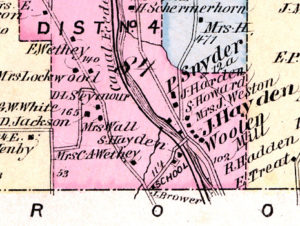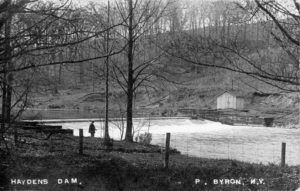This month I will finish out our tour of little settlements around the town by visiting Haydenville. This very small settlement was two miles upstream of Port Byron on what is today Route 38. It is marked by the intersection with Hayden Road and a small group of homes. Calling it a “ville” was generous as it was basically the home and business of the Hayden family. The entire reason for it’s existence was the steady and reliable flowing waters of the Owasco River and the flattening of the valley which made it the perfect site for a mill-seat.
With the great location, all that was needed was a diversion dam that would divert water into the mills. This dam was built by Charles and Amos Park and it was located just upstream of Hayden Road. In addition to serving the mills at Haydenville, this dam would be used to divert water to the large Beach’s Mill in the village and even later, to supply water to the Erie Canal. The dam was in use up to 1917.
The first mill owner at the site may have been Harry Rice who operated a wool carding and cloth dressing business. According to the Hayden family genealogy, Aaron Hayden had married Sarah Rice in the late 1700s, so there needs to be move investigation into how these families were related. Around 1824 William Hayden moved from Auburn to be next to the Rice mill and he began to manufacture wooden pails. In 1824 Brigham Young moved to Haydenville to work at this business before he moved to Port Byron. About 1826 the pail factory burned and Hayden purchased Rice’s woolen operation. The Hayden history notes that Hayden and his sons added equipment to produce cloth for the home market. It was known as Hayden’s Extra, durable, no-shoddy and flannels. This would have been a one stop operation from the cleaning of the raw wool to the production of cloth. Although I have yet to see any plans, the building would have been very large to accommodate all the machinery. And it was likely all stone as they tended to be somewhat fire and flood resistant, and they were more stable for the many spinning machines that spun the wool into thread and the looms that wove the thread into cloth. In 1860 the mill began to produce cloth for the state prisons at Auburn, Sing Sing, and Dannemora. And yet an article from1950 notes that many of the most prominent men of the county had suits made from fine Hayden cloth. So it was possible for them to produce better cloth, but likely not as profitable. It was reported that droughts in the 1880s reduced the flow of water putting the mill was out of business by 1890. It is likely that the old mill could not keep up with the newer larger steam powered mills.
In 2008 I wrote about the scandal of John Hayden and his wife Lizze Miller. John was the younger son of William. After fifteen years of an unfulfilling marriage, she took off to Washington DC and took up with Senator Roscoe Conkling. It was quite the to-do and involved lots of newspaper articles. John later tried to start a apple washing and production business in Haydenville, however the pollution being flushed downstream from Auburn made it impossible.
When the Auburn and Northern trolley line was built in the early 1900s, the new rail bed passed right over the site of the old mill. After the trolley went out of business in 1931, the state took the old bed and used it to straighten and improve Route 38. So finding the old mill site can be difficult as it is now under Route 38. This route change was such a drastic improvement that Bruce Carter had to film it and that can be seen on our YouTube channel. It shows a very quick snippet of the new highway.
Update- After this column ran in the Auburn Citizen, a local man sent me this postcard.
It was likely taken at the same time as the one of the dam. It looks as if the photographer was standing next to the gate house of the dam. The old mill race, canal feeder is in the foreground and the Outlet / river is in the back. You can see the road bridge on the left side. Sadly, there are no remains of the old mill to be seen.


